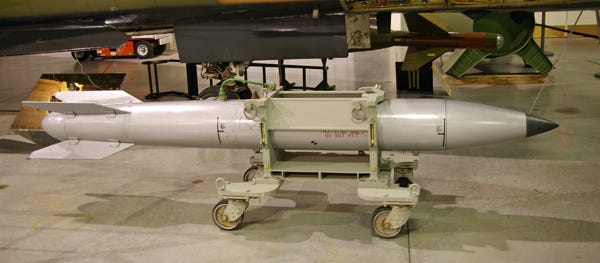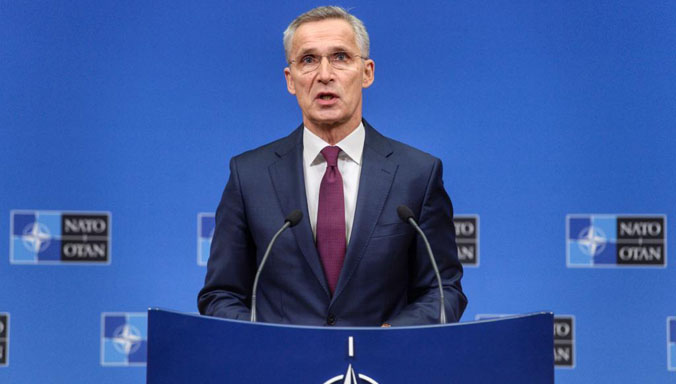Why Is NATO Expanding Its Nuclear Force?
NATO, 1 Jul 2024
Stephen Bryen | TFF Transnational Foundation - TRANSCEND Media Service
Is Washington Extending the Nuclear Umbrella to Ukraine?
“These are some of the many things NATO government leaders do not understand or refuse to take into account and discuss. They behave in a hugely provocative manner, and they have no knowledge about conflict-resolution and peace. And, thus, the West – not Russia – is causing a drift toward unparalleled catastrophe.”
– Jan Oberg, TFF Transnational Foundation
17 Jun 2024 – Jens Stoltenberg, the 13th secretary general of Nato, says that NATO is in talks to deploy more nuclear weapons and modernize their delivery systems. Stoltenberg told the Telegraph in the UK: “I won’t go into operational details about how many nuclear warheads should be operational and which should be stored, but we need to consult on these issues. That’s exactly what we’re doing.” Stoltenberg emphasized that NATO is a “nuclear alliance.” He explained: “NATO’s aim is, of course, a world without nuclear weapons, but as long as nuclear weapons exist, we will remain a nuclear alliance, because a world where Russia, China and North Korea have nuclear weapons, and NATO does not, is a more dangerous world,” he said.
The Russians say that Stoltenberg’s nuclear weapons declaration was “bully tactics.”
Stoltenberg could not act on NATO’s nuclear deterrent unless deeply coordinated with the United States. Thus the NATO expansion of nuclear weapons is a Biden administration policy and program.
Nuclear Sharing in NATO
NATO’s nuclear deterrence is based on nuclear sharing arrangements. As described officially: “NATO’s nuclear deterrence posture also relies on the United States’ nuclear weapons forward-deployed in Europe, as well as on the capabilities and infrastructure provided by Allies concerned. A number of NATO countries contribute a dual-capable aircraft (DCA) capability to the Alliance. These aircraft are central to NATO’s nuclear deterrence mission and are available for nuclear roles at various levels of readiness. In their nuclear role, the aircraft are equipped to carry nuclear weapons in a conflict, and personnel are trained accordingly.
”The United States maintains absolute control and custody of their nuclear weapons forward-deployed in Europe, while Allies provide military support for the DCA mission with conventional forces and capabilities.”
While NATO’s nuclear weapons are American, the UK and France have nuclear weapons too.
US nuclear weapons stored in Europe are nuclear gravity bombs that can be launched by NATO aircraft or by the US operating independently of NATO.
Technically nuclear gravity bombs fall into the category of tactical nuclear weapons. The US, UK and France also deploy strategic nuclear weapons in and around Europe. The UK has around 225 nuclear warheads (more than half in storage) for its Trident nuclear submarine program. The British nuclear capability requires US coordination.
France is the only NATO country with a fully independent nuclear arsenal that consists of ballistic missile submarines and a small number of cruise missiles with nuclear warheads. The French have floated the idea of replacing the US nuclear deterrent with a French one and there have been discussions with Germany about the idea. To some degree, Stoltenberg’s announcement on upgrading NATO’s nuclear alliance could be interpreted as offsetting French pressure to diverge from the US-led deterrent in Europe.
There has long been suspicion in Europe that the US would not launch nuclear weapons to defend European territory because of the risk of a nuclear exchange between Russia and the United States. To an unknown extent, the presence of tactical nuclear weapons (under US control) is intended to enable the US to use the tactical part of its nuclear arsenal reducing the risk of a strategic nuclear exchange with Russia.
Yet it is certainly the case that Stoltenberg’s emphasis on NATO as a nuclear alliance was primarily intended to offset fears that Russia could turn to nuclear weapons to settle the Ukraine conflict. Compared to the US, Russia has a vast arsenal of tactical nuclear weapons and many of its tactical missiles can be equipped with nuclear warheads. In fact, the Ukrainians have been warning Europe this is exactly what Russia could do.
The Russians have been conducting nuclear exercises and claim to have put nuclear weapons in Belarus, although none have been spotted there as of now. Likewise the US has been flying its strategic bombers close to Russia’s borders as a US warning.
Ukraine has also attacked two sensitive radar sites that are important parts of Russia’s early warning system. It is not clear why these targets were selected either by Ukraine or by NATO which supplies the weapons and intelligence for these attacks.
NATO relies on nuclear gravity bombs for deterrence. These weapons would be delivered against Russian targets by NATO aircraft. About 150 bombs are stored at six bases: Kleine Brogel in Belgium, Büchel Air Base in Germany, Aviano and Ghedi Air Base in Italy, Volkel Air Base in the Netherlands and Incirlik in Turkey. These are part of NATO’s nuclear sharing agreement.
In addition, the US announced in January that it was upgrading parts of the RAF Airbase at Lakenheath, Surrey, in the UK, where a special squadron, the 48th Security Force, of F-35s will be capable of carrying B-61 gravity bombs. The US is building special hydraulic loading ramps, upgrading storage facilities and installing a nuclear “shield” to protect personnel at the base. These F-35s will be operated solely by US pilots and are outside of NATO’s nuclear sharing arrangement, meaning that their mission could be linked to NATO’s security and deterrence, but could be used outside of any general NATO agreement.

US B-61 gravity bombs are close to completing a modernization program (Mod 12). The B-61 is a “dial a yield” weapon, meaning that the bomb yield can be adjusted to fit specific targets. The US also will retain some Mod 11 B-61 bombs.
The Mod 11 B-61 is regarded as a bunker buster bomb and is not “dial a yield.” It has a special 400 kt warhead. About 30 of these bombs were manufactured. It is not clear if they are deployed in Europe.
The Mod 12 B-61 can select yields (in kilotons) from .3, 1.5, 10 or 50 kt. For comparison purposes, the Hiroshima bomb was between 11 and 16 kt.
The modernization of the B-61 requires the modernization of the delivery systems, including changes in the aircraft’s electronics. There is very little information on how quickly the upgrades and changes can be made. New F-35s can carry B-61 bombs if they are equipped to do so. It isn’t known how many of the F-35’s delivered to Europe are nuclear capable.
Many Unanswered Questions
It is important to point out that neither the US nor NATO has any treaty obligation, or any other responsibility, to protect Ukraine from a nuclear attack. Therefore, NATO deterrence, at least insofar as it is understood, does not apply to Ukraine in any formal manner. But that does not mean that Stoltenberg, and by proxy the United States, is not shifting the alliance to extending a nuclear umbrella over Ukraine.
One reason to assess this may be the change in strategy underway is the NATO-US decision to unleash long range weapons in Ukraine on Russian territory. In the proxy wars prior to Ukraine, the US and Russia have been careful to avoid directly attacking each other. That is why Truman was against US forces crossing the Yalu River in Korea; why neither China nor Russia was attacked in the Vietnam war; why in the Cuban missile crisis President John F. Kennedy refused any nuclear attack on Cuba and the Soviet Union. But there were moments when tensions grew to approach the nuclear threshold.
That was especially the case in 1973 when Russia began threatening intervention with nuclear weapons in the Yom Kippur war, and when the US declared a DEFCON-3 alert. In the context of superpower rivalries and proxy and other conflicts (the Cuban Missile Crisis was not a proxy conflict but a direct confrontation between the US and USSR) NATO-approved attacks on Russian territory appear to cross a dangerous red line. When combined with the no negotiations and no talks, no peace posture of the US and most of Europe on Ukraine, the danger of an expanding conflict, or even one involving nuclear weapons, is increasing. Upgrading nuclear arsenals in that context adds fuel to the fire.
_______________________________________________
Stephen Bryen is a former Deputy Under Secretary of Defense and is a leading expert in security strategy and technology. Bryen writes for Asia Times, American Thinker, Epoch Times, Newsweek, Washington Times, the Jewish Policy Center and others.
Go to Original – thetransnational.substack.com
Tags: China, European Union, NATO, Nuclear Weapons, Russia, USA, Ukraine
DISCLAIMER: The statements, views and opinions expressed in pieces republished here are solely those of the authors and do not necessarily represent those of TMS. In accordance with title 17 U.S.C. section 107, this material is distributed without profit to those who have expressed a prior interest in receiving the included information for research and educational purposes. TMS has no affiliation whatsoever with the originator of this article nor is TMS endorsed or sponsored by the originator. “GO TO ORIGINAL” links are provided as a convenience to our readers and allow for verification of authenticity. However, as originating pages are often updated by their originating host sites, the versions posted may not match the versions our readers view when clicking the “GO TO ORIGINAL” links. This site contains copyrighted material the use of which has not always been specifically authorized by the copyright owner. We are making such material available in our efforts to advance understanding of environmental, political, human rights, economic, democracy, scientific, and social justice issues, etc. We believe this constitutes a ‘fair use’ of any such copyrighted material as provided for in section 107 of the US Copyright Law. In accordance with Title 17 U.S.C. Section 107, the material on this site is distributed without profit to those who have expressed a prior interest in receiving the included information for research and educational purposes. For more information go to: http://www.law.cornell.edu/uscode/17/107.shtml. If you wish to use copyrighted material from this site for purposes of your own that go beyond ‘fair use’, you must obtain permission from the copyright owner.
Join the discussion!
We welcome debate and dissent, but personal — ad hominem — attacks (on authors, other users or any individual), abuse and defamatory language will not be tolerated. Nor will we tolerate attempts to deliberately disrupt discussions. We aim to maintain an inviting space to focus on intelligent interactions and debates.
